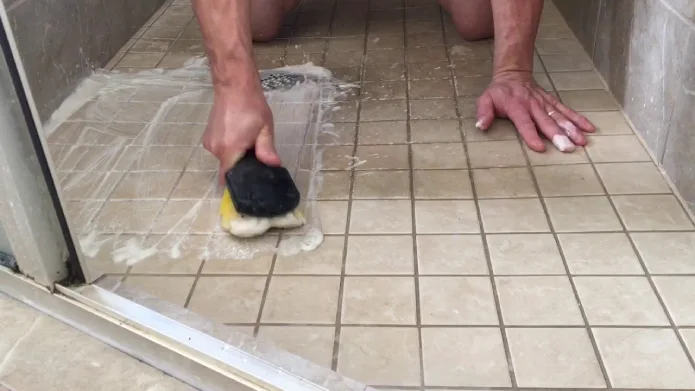Last Updated on November 14, 2023
Slippery bathroom floors can be a major hazard if not addressed properly. Taking on the challenge of cleaning them doesn’t have to feel daunting as long as you know what you’re doing. An informed approach is key to achieving satisfactory results.
There are several methods that can be used to clean your slippery bathroom floor, including using water and dish soap, commercial cleaners, vinegar, lemon juice, and baking soda. Each method has its own benefits.
We will discuss each method in detail and also explore why bathroom floors become slippery in the first place and what you can do to make them less slippery.
How to Clean Slippery Bathroom Floor: Different Methods
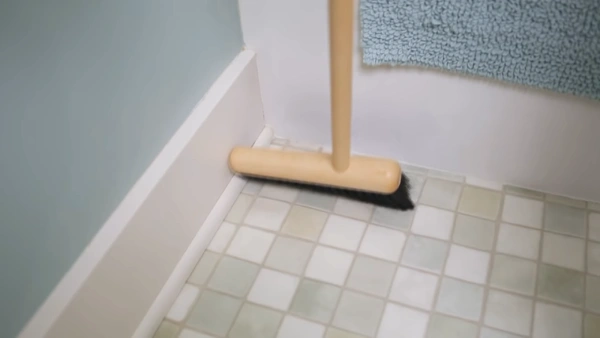
Before tackling that slippery bathroom floor, make sure to equip yourself with some non-slip slippers. Then follow and apply the methods below to keep your bathroom floor spotless and safe.
Method 1: Cleaning with Water and Dish Soap
One of the best ways to clean a slippery bathroom floor is with water and dish soap. This method is cheap, simple, and can be used on various bathroom surfaces like ceramic tile floors, porcelain tile floors, etc. The dish soap breaks down the slipperiness and filth, so you don’t slip.
To begin, you should fill a bucket with warm water and add a few drops of dish soap. If the floors are particularly dirty, you may need to add more soap than just a few drops.
Once the bucket is ready, use a microfiber mop to spread the soapy mixture over the floor. You should start at one corner of the room and work your way out in long strokes. Let the mixture sit for several minutes.
Then scrubbing with a brush or rag to remove any remaining dirt or grime from the floors. Finally, rinse all remaining residue with clean water using either a mop or sponge.
Method 2: Cleaning with Commercial Cleaners
In addition to using water and dish soap for cleaning slippery bathroom floors, using the best commercial bathroom cleaner is another viable option that can offer even better results.
Before utilizing this method, it’s important that you read any instructions printed on the product label carefully. Some products may need special application instructions or protective gear, like gloves.
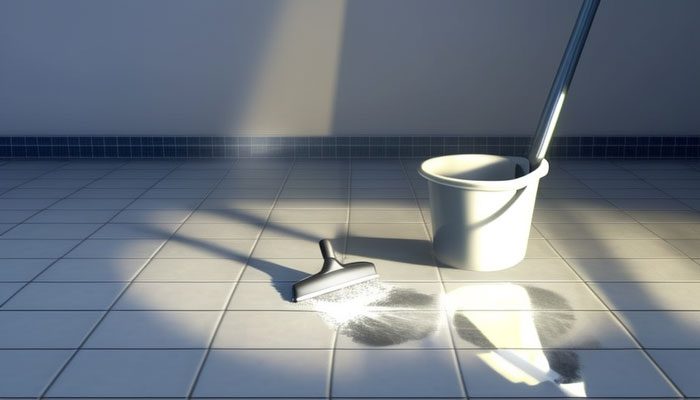
To begin cleaning your bathroom floor with these products, start lightly spraying an even layer over the affected area in long strokes starting from one corner of the room outwards.
Depending on what type of cleaner you are using, you may need to let this sit for several minutes before scrubbing away dirt and grime with either a brush or rag.
Once scrubbing, rinse off any remaining residue with clean water until there is no longer any trace of cleaner left behind on the tile floor surface.
Method 3: Cleaning with Vinegar
Cleaning slippery bathroom floors using vinegar is a safe and effective way to tackle this common problem. Vinegar is safe for most bathroom floors, like porcelain, ceramic, or vinyl floors.
The first method involves mixing equal parts of white distilled vinegar and water in a bucket, then using a mop to apply the mixture onto the floor.
Acidity in the vinegar helps break down grime and slipperiness on the floor. Once applied, let it sit for 10-15 minutes. Then wiping up with a cloth or sponge.
For tougher areas, use an old toothbrush to scrub away any stubborn dirt or stains. After cleaning, be sure to wash off any leftovers. This will also help reduce any strong odors that may occur due to the vinegar’s acidic properties.
There’s a second method for cleaning slippery bathroom floors with vinegar that’s a little more complicated, but it can get better results.

In a bucket, mix one cup of white distilled vinegar with one cup of salt. Then add two tablespoons of liquid soap and mix until all ingredients are combined.
Dip your mop into the mixture, wring it out so as not to over-saturate your floor, and apply it liberally across your shower floor surface. Let the floor sit for 15 to 20 minutes.
Use a PVC bristle brush to scrub the floor. This will help get them up better than just mopping alone. Finally, rinse all residue with clean water and dry thoroughly before walking on the surface again.
Method 4: Cleaning with Lemon Juice
Cleaning slippery bathroom floors using lemon juice is another great option for those looking for natural solutions to this common problem.
Lemon juice has natural acidic properties, which help break down filth that can accumulate on bathroom surfaces over time. It also helps freshen and deodorize them.
To start, cut one lemon into slices. Then take 2 tablespoons of lemon juice and mix it with 2 cups of warm water in a bucket or spray bottle. You can use whichever you prefer depending on how large your surface area is.
Spray the cleaning solution over the floor. Mop across the entire surface area, making sure to cover all corners where scum likes to hide.
Leave the area for 10 minutes. Scrub away at any areas that still have residue. Rinse off the area with clean water. Dry the area thoroughly before walking on it again.
Method 5: Cleaning with Baking Soda
Baking soda is another excellent cleaning agent for slippery bathroom floors. To use baking soda for cleaning your bathroom flooring, combine half a cup of baking soda plus 1/4 cup of hydrogen peroxide into a paste-like consistency in a bowl.
Using either a cloth or sponge applicator, spread the paste on any slick areas on your bathroom floor tile surface before scrubbing it in gently with either an old toothbrush or scrub brush.
Allow this solution to sit for anywhere between 10-15 minutes before rinsing off with hot water and drying completely. You may notice that this method will also help further neutralize odors caused by mildew buildup over time as well.
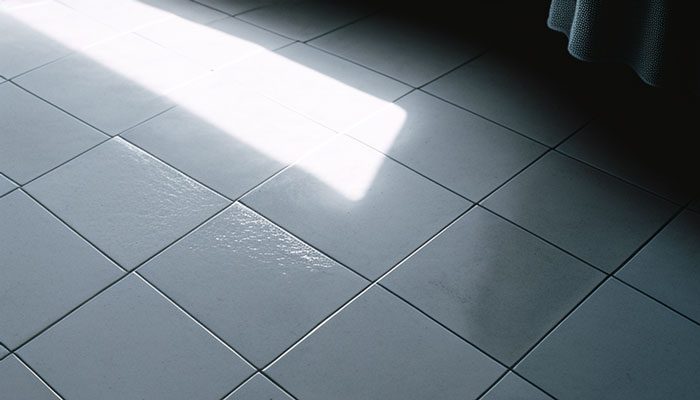
Another method under baking soda is the combination of baking soda and lemon juice. Begin by making sure that all dirt and debris have been swept away from your bathroom floor tiles before starting this deep cleaning process.
Then mix together one tablespoon of baking soda mixed with two tablespoons of fresh lemon juice into a thick paste-like substance in a bowl or measuring cup.
Apply to tile surfaces using either an old cloth rag or sponge applicator while taking special care not to rub too hard so as not to damage delicate grout lines between tiles.
Let this mixture sit for about 15-20 minutes. Then, use an old toothbrush or special tile scrubber to clean it off gently. In the end, rinse and dry thoroughly before admiring your newly sparkling clean tiles.
Why Is My Bathroom Floor So Slippery?
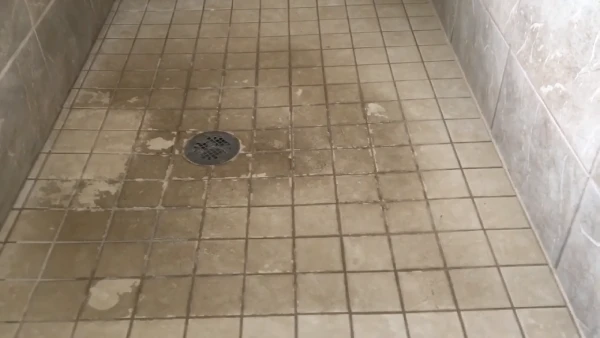
Unstable bathroom surfaces can be an invisible threat to anyone who steps inside! It’s essential to recognize why slippery floors are so hazardous and find a way to turn a treacherous terrain into a safe footing. Let’s dive deeper and explore the potential causes of this slippery situation.
1. Residual Soap
When it comes to having a slippery bathroom floor, one of the main culprits is residual soap. Soap residue can build up on bathroom floors over time, creating a slick surface that can be dangerous and make it difficult to maintain your footing.
This can happen when soap is not rinsed off completely from the shower or bathtub after use, allowing it to build up and dry on the floor.
Residual soap can also accumulate on the bottoms of wet towels and rugs that are used in the bathroom and then left on the floor for an extended period.
To avoid this issue, it is important to rinse all soap off after using it and to ensure that any wet towels or rugs are hung up or placed in an appropriate container until they have dried completely.
2. Leaky Showerhead
Another potential issue that may be causing a slippery bathroom floor is a leaky showerhead. When water leaks out of a showerhead, it can drizzle down onto the bathroom floor, which creates a slick film that makes it challenging to navigate without slipping.
If this issue isn’t caught soon enough, water can build up on parts of the floor, making its way into grout lines and seams, which cause even more slipperiness.
To fix this problem, you should check for any visible signs of leaking, such as dripping water or damp spots on the walls or ceiling near the showerhead.
You should also inspect your plumbing fixtures for signs of water damage, such as discoloration or rusting metal pipes.
3. Wet Towels and Rugs
When wet towels and rugs are left on bathroom floors for an extended time, they can trap moisture under them, which leads to a slippery surface.
To prevent this from happening, these items should be hung up or stored as soon as possible after they have been used so that they don’t leave behind excess moisture on the floor.
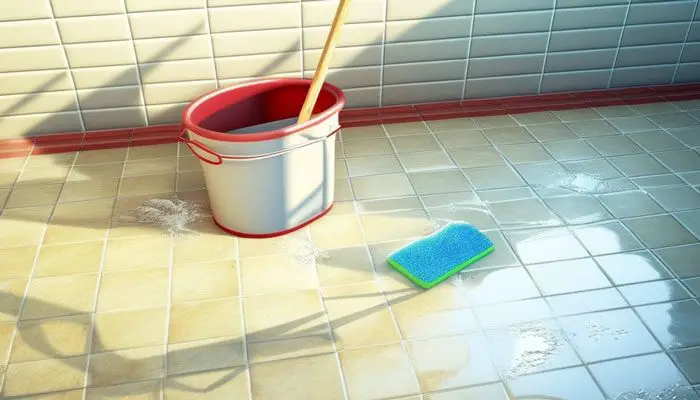
Also, if you have carpets or rugs in your bathroom, they should be vacuumed regularly so that dirt particles don’t accumulate between fibers which could create another slippery layer over time.
4. Buildup of Mildew and Mold
When mildew and mold accumulate, it can cause a slippery bathroom floor. This is because the microorganisms release a slimy substance as they grow, which can make the surface of the tile or linoleum appear slick and slippery.
These organisms thrive in warm areas with plenty of moisture, such as bathrooms where showers are frequently used.
Even if there are no visible signs of mildew or mold, their presence can be detected by musty odors in the air or discoloration on walls, shower curtains, and other surfaces.
Removing them thoroughly with a strong cleaner and cleaning them more regularly is the best way to prevent them from making your bathroom floor slippery.
5. Residual Shampoo & Conditioner
Frequent use of shampoos and conditioners can also lead to a slippery bathroom floor. After washing your hair in the shower, some products are not rinsed off completely and remain on the surface of your bathroom tiles.
This can create an oily film that causes your feet to slip around when you step out onto the ground while still wet from the shower.
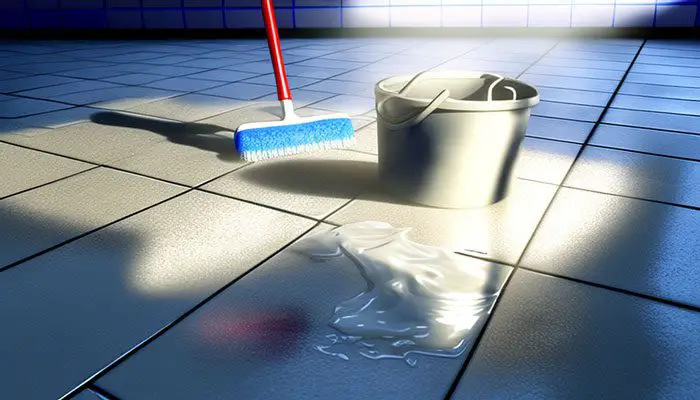
To reduce this kind of slipperiness, it’s essential to rinse off any residual shampoo or conditioner after each wash so that it does not build up over time.
6. Unclean Floor
An unclean floor can also create a slippery surface that can increase the likelihood of slips and falls in the bathroom setting.
Filth, hair, oils, soap scum, and other substances accumulated over time can lead to a slick surface when exposed to moisture from showers or bath water spilling onto the ground.
To provide adequate protection against slips and falls caused by unclean floors, routine dust mopping should be done at least once per week to remove all debris that may have accumulated since the last time it was swept up.
Also, heavier scrubbing and cleaning should be conducted periodically to tackle any stuck-on residue that may have developed over time due to negligence in upkeep duties.
7. Using the Wrong Cleaning Products
If you use the wrong cleaning products, it can make your bathroom floor slippery. This happens when the chemicals in the products have a bad reaction with each other.
You should never use different types of cleaners together, like ones with ammonia or bleach. If you do, it could create a bad reaction that would cause problems, like slippery surfaces in the bathroom after someone takes a shower.
It is a good idea to use different cleaners for different parts of the bathroom. For example, use one cleaner to mop the floor and another cleaner for the tile grout. This will help keep your bathroom clean and safe.
What Can I Put On My Bathroom Floor to Avoid Unexpected Slipping?

Using non-slip products can help to minimize the chances of slipping in the bathroom. Installing a non-slip shower mat provides an extra layer of protection when stepping in and out of the shower.
Non-slip stickers provide a quick and easy solution that is also aesthetically pleasing. For more long-term, durable protection, slip-resistant floor coatings are available. These coatings can help reduce slips and falls in wet areas such as bathrooms and showers.
Also, grip bars installed near the bathtub or shower can help to ensure a safe transition from one area to another. Lastly, it is essential to remember to clean the bathroom floor regularly, as built-up dirt and grime can make surfaces slippery and dangerous.
Avoid Floor Slips and Falls: Protect Your Bathroom with Cleaning & Prevention Strategies
Keeping your bathroom floor safe and slip-free is essential to ensuring you don’t take an unexpected tumble.
By regularly cleaning your bathroom floor with water and dish soap combined with one of the other methods discussed in this blog post, such as vinegar or baking soda, you can ensure that your bathroom remains safe from unexpected slips and falls.
You can further reduce the likelihood of accidents happening by understanding why bathrooms become slippery and taking steps to prevent them, like using non-slip stickers or slip-resistant floor coating.

